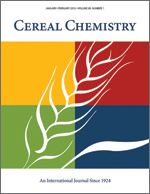
Cereal Chem 69:423-428 | VIEW
ARTICLE
Studies on Frozen Dough. II. Flour Quality Requirements for Bread Production from Frozen Dough.
Y. Inoue and W. Bushuk. Copyright 1992 by the American Association of Cereal Chemists, Inc.
Extensigraph properties and bread loaf volumes were determined for frozen doughs that had been stored for up to 10 weeks or thawed and refrozen after an initial frozen storage period of one week. Four flours were used: three differed in protein quality (strength) but contained approximately the same amount of protein, and two had the same protein quality but differed in protein content. A modified extensigraph procedure developed for fermented doughs was used in this study. Yeast activity was assessed with the gassing power test. Extensigraph results (maximum resistance and extension) showed that dough strength decreased markedly on freezing and thawing and gradually during frozen storage. Similarly, loaf volume decreased markedly with freezing and thawing and gradually during frozen storage. Results of experiments in which yeast activity was maintained at the same level as that in nonfrozen doughs showed that the loss of dough strength on freezing, on thawing, and during frozen storage was the main reason for the decline in bread loaf volume. Accordingly, for best bread quality from frozen doughs, very strong flours should be used. Protein content, in the range covered in the present study, appears to be less important than protein quality.